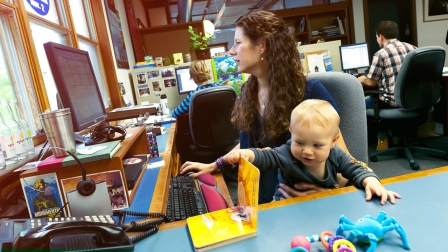Patagonia’s CEO Explains How To Make On-Site Child Care Pay For Itself
To support our families, Patagonia provides company-paid health care and sick time for all employees; paid maternity and paternity leave; access to on-site child care for employees at our headquarters in Ventura, California, and at our Reno, Nevada, distribution center; and financial support to those who need it, among other benefits. In particular, offering on-site child care, we believe, is the right thing to do for employees, working parents, and the life of the workplace.
However, a reasonable businessperson might ask, “What does it cost?” It’s expensive if you offer high-quality care and subsidize your employees’ tuition—but not as expensive as you’d think.
Child Care Isn’t Just A “Nice-To-Have”
The poet Maya Angelou said, “When you know better, you do better,” but despite everything we know about the tangible and intangible benefits of taking care of our working families, collectively, we American business leaders provide paid family leave to just 11% of U.S. workers.
To date, three states and the District of Columbia offer paid family leave: California, New Jersey, and Rhode Island. The United States is one of only two countries in the industrialized world that offers no federal paid maternity leave. And every day in America, most women return to work after the birth of a child to find an unsupportive environment lacking on-site child care, lactation programs, and paid medical leave.

We don’t have to scratch our heads and wonder why there’s an alarming lack of women in leadership, boardrooms, and public office. Women will never be able to effectively “lean in” without the proper economic, social, and community support for the most critical work of all—raising the next generation. The good news for skeptical business leaders, though, is something I’ve learned firsthand: Supporting our working families isn’t just the ethical thing to do (which, frankly, should be reason enough for responsible leaders); it will also balance out financially.
Research showing the business benefits of paid family and medical leave and other critical programs is abundant. For now, though, let me illustrate the basic math that gives me confidence as Patagonia’s chief executive not only to provide on-site child care to our parents at our headquarters, but, as of this year, to expand it to our 400-employee distribution center in Reno, Nevada, as well.
Tax Benefits
Costs recouped: 50%
The federal government recognizes the value of on-site child care to both working parents and the economy, and grants a qualified child-care program a yearly tax credit of $150,000. In addition, the government allows a company to deduct 35% of its unrecovered costs from its corporate tax bite.
To date, costs after revenues (tuition fees) for running Patagonia’s child development center are approximately $1 million. With a yearly tax deduction of $150,000 and a second deduction of 35% of costs (35% of $1 million = $350,000), that’s a total of $500,000 in costs recouped, or 50%.
Employee Retention
Costs recouped: 30%
Turnover costs (of losing an employee and training a replacement) include lost productivity while the position is vacant, plus recruitment, relocation, and training time. This can range from 35% of annual salary for a non-managerial employee, to 125% of salary for a manager, to a couple of years’ pay for a director or vice president. In the United States, 20%–35% of working mothers who give birth never return to their previous job.
At Patagonia, for the past five years, we’ve seen 100% of moms return to work after maternity leave. Moreover, the availability of on-site child care remains important for allowing mothers to breastfeed infants on demand. For the past five years, our turnover rate for parents who have children in the program has run 25% less than for our general employee population.
To calculate our retention-related savings due to on-site child care, we first estimated the additional turnover we’d have if we didn’t offer an on-site child-care center, and then estimated the cost of that turnover. This actually took three steps: calculating the cost of turnover, then the effect of on-site child care on turnover, and finally multiplying the cost of that turnover by how much we expected to reduce it.
Employee Engagement
Costs recouped: 11%
The term “engagement” is used to measure wholeheartedness or simply how an employee feels about his or her job and employer. Higher engagement creates higher levels of customer satisfaction and business performance. Studies indicate that when parents have access to high-quality, on-site child care at work, they are more engaged—even more so than colleagues as a whole—and that increased engagement means the company does better financially.
We arrived at our 11% savings figure by first estimating the effect of on-site child care on the engagement of parents who use the program, then multiplied that by the estimated effect of parents’ engagement on the company’s financial performance.

Bottom Line
Costs recouped: 91%
In sum, we estimate that we recover 91% of our calculable costs annually. We’re not alone. JPMorgan Chase Bank, N.A., has estimated returns of 115% for its child-care program; global business consultant KPMG found that its clients earned a return on investment (ROI) of 125%.
Of course, this quantifiable picture leaves out the obvious intangible benefits of providing on-site child care. All told, we would say that an ROI of 115% or 125% on our own program wouldn’t surprise us. Benefits in the intangible category include:
More women in management. Studies show that a healthy gender mix at the leadership level makes business smarter and more creative and improves performance. At Patagonia, women make up 50% of our workforce, including roughly half of upper management positions.
Greater employee loyalty. Providing high-quality, on-site child care helps a business exercise its obligations as an employer and community citizen. Such businesses earn the trust of their employees, who give their time more wholeheartedly, and the loyalty of customers, who will buy from a brand, all else being equal, with the better reputation.
A stronger workplace culture of trust. At Patagonia, if you ask parents the benefit of having their child on site, they might tell you what a difference it makes to be able to check in, have lunch together, and be freed from the complications stemming from dropping off and picking up the child elsewhere. If you ask a non-parent the greatest benefit of having the kids around, he or she might tell you that it reminds us—parents and non-parents alike—that we’re behaving for real in a real world, and not just hired guns asked to leave our deepest selves behind the moment the workday starts.
For 33 years, Patagonia has provided on-site child care—a mandate from our founders, who believed it was a moral imperative. Even in times of economic struggle the program was never cut, because they believed in providing a supportive work environment for working families. Taking care of our tribe is part of our culture and our commitment to helping our own people live the way they want. It’s true, there are financial costs to offering onsite child care, and they can be expensive if you offer high-quality programs or subsidize your employees’ tuition when onsite care is not available.
But the benefits—financial and otherwise—pay for themselves every year. As a CEO, it’s not even a question in my mind. Business leaders (and their chief financial officers) should take note.
This article is adapted from Family Business: Innovative On-Site Child Care Since 1983. ©2016 Patagonia Works. All rights reserved. It is reprinted by permission of Patagonia.
Fast Company , Read Full Story
(34)


